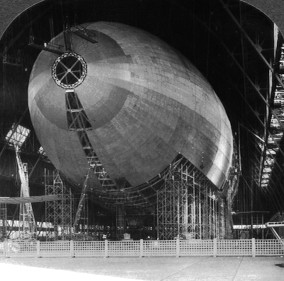Lighter than Air
Today, we ask if we'll ever ride in a dirigible. The University of Houston's College of Engineering presents this series about the machines that make our civilization run, and the people whose ingenuity created them.
Four government agencies met in 1975 -- NASA, the FAA, the Navy, and the Department of Transportation. They gathered in a workshop to reassess lighter-than-air flight. This meeting took place 39 years after the German zeppelin Hindenburg burned at Lakehurst, New Jersey, and virtually put an end to commercial airships.
The Hindenburg disaster branded flammable hydrogen as unsafe for buoying these great whales up in the sky. It had to be replaced with helium. But, on the eve of WW-II, we controlled the world supply of helium. When Germany couldn't get helium, dirigibles went out of business.
The 1975 workshop didn't just ask whether these gentle monsters should be made to fly again. It also brought to light a stunning array of extensions of the old technology -- things like hybrid airships with airfoil-shaped bodies to add lift in flight; small blimps for urban transport; airships with different shapes; blimps to move large, heavy items that won't fit in airplanes; airships for all payloads, ranges, and speeds.
The workshop concluded that the potential for airships is enormous, but that the question of economic feasibility won't be answered in a paper study. Someone, they said, must bite the bullet and make a commercial venture to answer that question.
Thirteen years have passed, and we see few commercial blimps or dirigibles in the sky. Perhaps American industry has failed to respond to the challenge and take the risk, but perhaps not. The technology is, in fact, returning. The lumber industry is considering load-carrying blimps to move large logs out of remote places. The Navy, which gave up airships 25 years ago, recently let contracts for a large surveillance blimp. And we find a new interest in developing commercial sightseeing blimps.
Whether we'll ever again have the chance to ride a stately zeppelin across the Atlantic -- dining in palatial elegance -- is not clear. One problem with airships is that their slow speed makes schedules terribly vulnerable to changing winds.
The dirigible wrote a strange chapter in the history of technology. It's a beautiful machine that's come and gone but may yet return. That sort of thing doesn't often happen, but lighter-than-air flight suffered a strange detour in its development. The airplane distracted us from its potential, but I think we'll see it again.
I'm John Lienhard, at the University of Houston, where we're interested in the way inventive minds work.
(Theme music)
This episode has been substantially rewritten as Episode 1507.

(Stereopticon image courtesy of Margaret Culbertson)
The post-WW-I American Dirigible Akron under construction. An age that we've left behind.